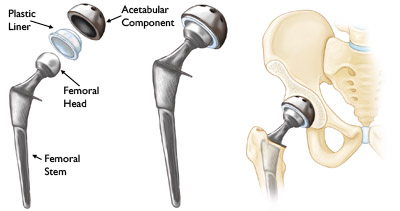What are some Cautionary Movements for Hip Replacements?
What are some Cautionary Movements for Hip Replacements?

From Justine:
Hip Replacement: It depends indeed!! The MAIN thing you need to know from your student is what the doctor told them NOT to do, and go by that. AND, constant reminders of No Pain No Pain. They should not push through pain. With hip replacements, it depends on the approach (posterior lateral or anterior)….they are going more and more to anterior approaches, and that is not as complicated – the posterior/lateral approach requires the scar tissue from the cut to heal, as that is what stabilizes the joint. If any thing feels weird, have the stop immediately. I have had students with hip and/or knee replacements that you would never know if they hadn’t told you, and I have had students with VERY limited ROM (range of Motion). As far as the knee replacement – a goal is to get at least 90 degrees of flexion back, more can be attained, but it is against the clock as the scar tissue forms very quickly.
Here is an excerpt from an Yoga Vista Academy manual on Hip replacements: Hip Replacement Surgery
Two approaches – Posterior/Lateral and Anterior: Posterior/Lateral has traditionally been the most common, but is also the most unstable. Anterior approaches are done more often on younger, more active people and athletes. Recovery for healing avascular tissue (ie. ligaments) is one year. The scar tissue that forms around the joint helps bind the hip back together. In the posterior/lateral approach, the hip is dislocated and the ligaments are cut.
Precautions/Contraindications for Posterior/Lateral Approach.
• Can’t bend hip (flexion) past 70-90 degrees – even when sitting in a chair. You can dislocate the hip! For at least 3 months, sometimes forever.
• No hip adduction – taking the leg across the midline of the body. For at least 3 months, sometimes forever.
• If feeling funny deep in the joint – STOP.
• Supine twisting – ONLY with support between the knees and NOT past 90 degree hip flexion.
• No internal rotation from neutral.
Precautions/Contraindications for Anterior Approach Hip Replacement
• Precautions are opposite of the posterior/lateral approach.
• No extension of the hip joint, no abduction (moving leg away from the midline) and no external rotation – any combo of these can cause dislocation – one at a time is okay.
In regards to hip replacements, if you know the approach that was used physics will help you remember the precautions – for example, if the back of the hip was cut and someone pulls the knee to the chest, there will be pressure sent to the back of the hip risking dislocation. Always encourage your students to listen to their bodies first and foremost – and if anything doesn’t feel right, don’t do it! Back out immediately and rest.

